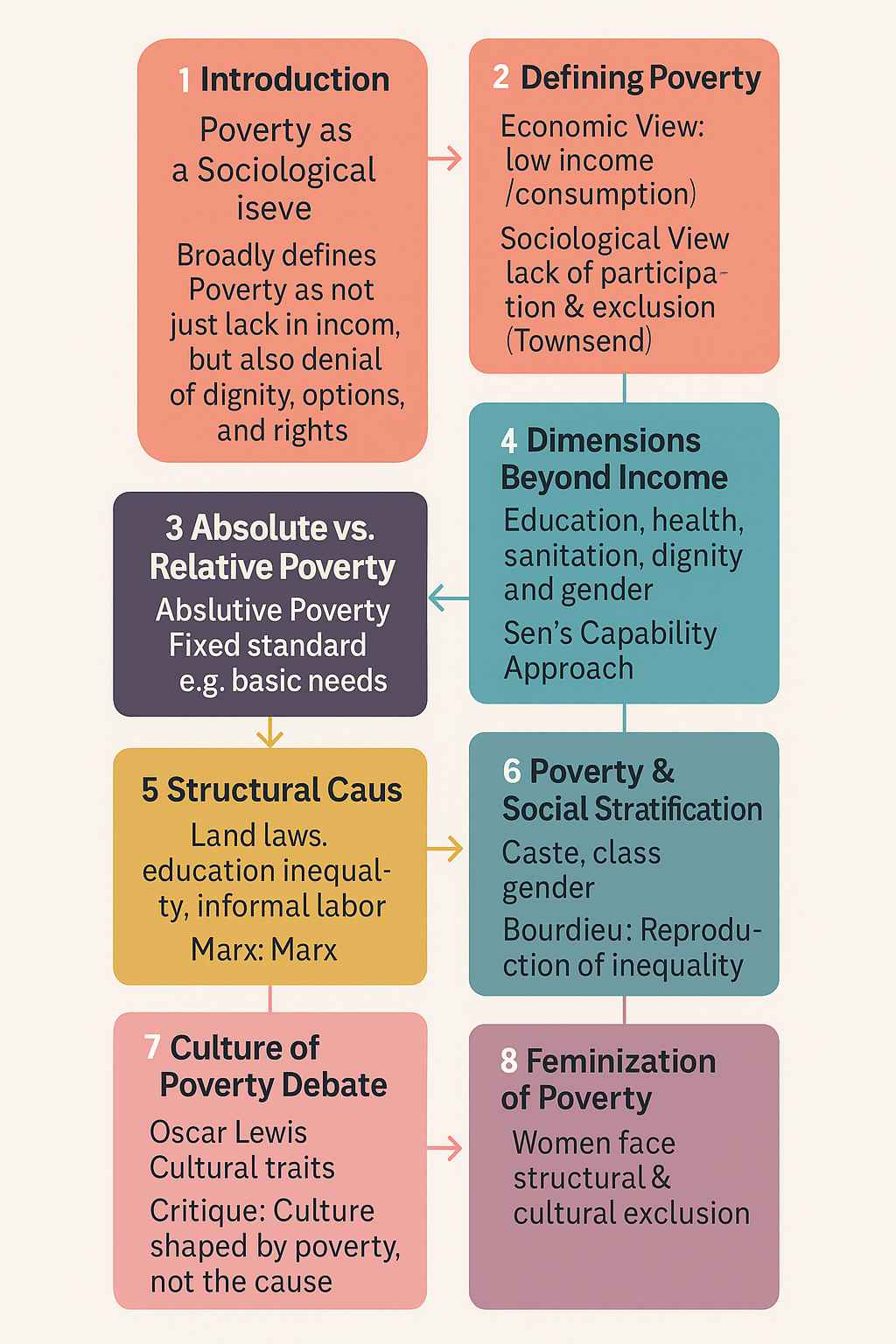Poverty
Index
- Introduction: The Sociological Problem of Poverty
- Defining Poverty: Economic and Sociological Perspectives
- Absolute vs. Relative Poverty: A Conceptual Distinction
- Dimensions of Poverty: Beyond Income
- Structural Roots of Poverty
- Poverty and Social Stratification
- Social Exclusion and Marginalization
- Cultural Interpretations: The “Culture of Poverty” Debate
- Feminization of Poverty
- Urban and Rural Poverty: A Comparative Lens
- Globalization, Neoliberalism, and New Poverty
- Measurement of Poverty: Indicators and Indices
- Anti-Poverty Programs and Their Effectiveness
- Critique of Poverty Discourses

Introduction: The Sociological Problem of Poverty
Poverty is not merely the absence of money; it is the absence of options, of opportunity, and often of dignity. Sociologists insist that poverty must be analyzed in terms of social relations, institutional arrangements, and historical processes. For instance, poverty in India cannot be fully understood without engaging with the historical legacy of caste discrimination, colonial economic extraction, and gender-based exclusion. Similarly, in global contexts, poverty is linked to patterns of imperialism, global capitalism, and uneven development. A sociological view sees poverty as produced, not accidental. It emerges through policy choices, economic priorities, and social norms that determine who gets access to resources and who does not.
Defining Poverty: Economic and Sociological Perspectives
While economists focus on income or consumption levels, sociologists highlight social positioning and lived experiences. Being poor means being left out—not only from markets but also from networks of social belonging, institutional trust, and political representation. Sociologist Peter Townsend emphasized that poverty occurs when people lack the resources to “participate in the activities and have the living conditions and amenities which are customary or at least widely encouraged or approved” in their society. Thus, a middle-income person in rural Bihar might still be poor in terms of connectivity, healthcare, or dignity, even if they technically exceed a monetary poverty threshold.
Absolute vs. Relative Poverty: A Conceptual Distinction
Absolute poverty is universal but rigid. A tribal family living in a forest might be technically “poor” in monetary terms but rich in terms of community ties, ecological access, and autonomy. On the other hand, relative poverty accounts for what people should have in their societal context to live with self-respect. This makes it more ethically sensitive. For example, in urban India, lack of digital access during the COVID-19 pandemic rendered many relatively poor, as schooling, governance, and even healthcare moved online. Relative poverty highlights the social injustice and inequality embedded within prosperity
Dimensions of Poverty: Beyond Income
Poverty must be understood as multidimensional. A family with just enough income to feed itself might still live in poverty if:
- The children cannot go to school.
- The household lacks electricity, toilets, or clean drinking water.
- Women are burdened with unpaid work and lack medical care.
- The community faces caste-based exclusion or ethnic violence.
Amartya Sen’s capability approach encourages us to ask not what people have, but what they can be and do. The inability to exercise choice, pursue dreams, or engage in public life—these are just as critical as food or money. This lens is crucial in a society like India where gender, caste, and region powerfully intersect with income to dene the quality of life.
Structural Roots of Poverty
From a structural point of view, poverty is reproduced and sustained by institutions. For example:
- Land ownership laws have historically favored upper-caste, male-dominated communities.
- Education systems privilege English-speaking, urban elite norms.
- Labour markets rely on cheap, unorganized labour with no social security
- Social welfare often fails to reach the most marginalized due to exclusion errors.
Karl Marx would argue that poverty is a functional necessity for capitalism—keeping a reserve army of labour that can be exploited at lower wages. In India, this is evident in the massive informal sector where migrant workers are underpaid, uninsured, and invisible. Poverty here is not accidental but structurally entrenched and systemically necessary to maintain elite lifestyles and profits.
Poverty and Social Stratification
Poverty disproportionately affects those at the bottom of social hierarchies. Caste is a classic example in India. Despite legal protections, Dalits continue to face educational, occupational, and residential discrimination, limiting their upward mobility. The Scheduled Tribes, similarly, face alienation from land, forests, and markets, despite their ecological stewardship.
Class-based stratification further compounds this. Those born into poor households often inherit not just poverty but also poor social capital—no networks to get jobs, no role models, no legal support. Sociologist Bourdieu termed this the “reproduction of inequality”—how economic and cultural disadvantage passes from one generation to the next.
Cultural Interpretations: The “Culture of Poverty” Debate
Oscar Lewis’s theory that the poor develop a distinct “culture of poverty”—fatalistic, dependent, and apathetic—was an attempt to humanize poverty but ended up being used to blame the poor. Critics like Herbert Gans and Paul Willis showed that what appears as apathy is often resistance or adaptation. A street child may not attend school not due to disinterest but because of hunger, harassment, or the need to work.
Rather than locating the cause of poverty in culture, sociologists focus on how culture is shaped by poverty—how survival strategies emerge under conditions of prolonged deprivation and how those strategies are misread by outsiders.
Feminization of Poverty
The feminization of poverty highlights how gender roles, combined with economic inequality, place women at a higher risk of poverty. In rural India, for example:
- Women are often landless even when they work the elds.
- Widows and single mothers are neglected by state welfare
- Girls may drop out of school early for unpaid caregiving or domestic work.
- Maternal mortality, anemia, and reproductive exploitation are common.
Unpaid care work done by women is excluded from GDP and policy considerations. Feminist scholars argue for “time poverty” as a critical dimension—where women lack the time to study, rest, or engage socially due to endless labour at home. True poverty alleviation requires gender-transformative policies that address both economic and social constraints.
Urban and Rural Poverty: A Comparative Lens
While rural poverty is rooted in agrarian crisis, land inequality, and poor infrastructure, urban poverty is shaped by informal labor, housing crisis, and commodified public services.
- In rural Bihar, lack of irrigation or credit can keep farmers indebted for life.
- In Delhi, migrant workers may live in shanties without legal rights, exploited by contractors, and unable to afford school or healthcare.
- Urban slums often lack clean water, electricity, and sanitation. Children fall ill, and women face violence and eviction threats.
Urban poverty tends to be invisible to policy makers but highly visible in space—near construction sites, bus stops, garbage dumps. Yet slum evictions often happen without providing legal recourse or alternative shelter, leading to a cycle of displacement and destitution.
Globalization, Neoliberalism, and New Poverty
In the era of neoliberal reforms, poverty has taken new forms:
- Formal jobs are shrinking; informal work has increased
- Privatization of healthcare, education, and transport excludes the poor.
- Global commodity markets have displaced small farmers.
- Technology has created digital exclusion for those without access to devices or skills.
Measurement of Poverty: Indicators and Indices
Quantifying poverty is both essential and controversial. Traditional poverty lines based on
caloric intake or expenditure often underestimate real deprivation.
Newer approaches include:
- Multidimensional Poverty Index (MPI): Developed by UNDP and Oxford Poverty & Human Development Initiative, this includes education, health, and living standards.
- Human Development Index (HDI): Measures income, literacy, and life expectancy.
- Gini Coecient: Measures inequality within a society.
- Global Hunger Index (GHI): Reflects undernutrition, child mortality, and food insecurity
However, sociologists caution against relying solely on numbers. Poverty has qualitative aspects—shame, vulnerability, hopelessness—that are often missed in quantitative indicators.
Anti-Poverty Programs and Their Effectiveness
India has a long history of welfare schemes, including
- MGNREGA: Provides rural employment.
- PDS: Ensures subsidized food grains.
- PM Awas Yojana: Aims at housing for the poor.
- National Social Assistance Programme: Provides pensions to elderly and widows.
However, these programs face challenges:
- Corruption and leakages
- Identity verication failures (Aadhaar-related exclusions)
- Gender-blind policy designs
- Limited coverage and underfunding
Sociological analysis demands a bottom-up perspective, asking: Are the poor consulted? Do the schemes respect dignity? Are they rights-based or charity-driven?
Critique of Poverty Discourses
Finally, sociologists critique the hegemonic narratives around poverty:
- That poverty is natural or inevitable.
- That poor people are lazy or responsible for their condition.
- That aid or charity is enough.
- That economic growth alone will solve everything.
Such discourses serve to depoliticize poverty, shifting attention away from power, policy, and privilege. Instead, sociology insists that poverty is a moral crisis of society, not of the individual. It calls for redistribution, representation, and resistance.
References
- Sen, Amartya. (1999). Development as Freedom. Oxford University Press
- Lewis, Oscar. (1961). The Children of Sánchez: Autobiography of a Mexican Family. Random House.
- Townsend, Peter. (1979). Poverty in the United Kingdom: A Survey of Household Resources and Standards of Living. Penguin Books.
- Silver, Hilary. (1994). “Social Exclusion and Social Solidarity: Three Paradigms.” International Labour Review, 133(5–6), 531–578.
Poverty can be defined in a range of different ways: as lack of resources or income available to purchase necessities or to achieve an acceptable standard of living; through actual levels of expenditure; as deprivation indicated by the lack of essentials; as lack of the capability to achieve particular standard of living, whether or not that standard of living is achieved; or as inability to participate in the activities of everyday life. At the same time, sociological attention to inequality has focused on a range of different inequalities: inequality of income; health inequalities; educational inequalities, or inequality of educational opportunity.
According to sociologists and researchers there are two different approaches to poverty: absolute poverty and relative poverty. The concept of absolute poverty is grounded in the idea of subsistence, the basic conditions that must be met in order to sustain a physically healthy existence. People who lack these fundamental requirements for human existence such as sufficient food, shelter and clothing are said to live in poverty. The concept of absolute poverty is seen as universally applicable. It is held that standards for human subsistence are more or less the same for all people of an equivalent age and physique, regardless of where they live. Any individual, anywhere in the world, can be said to live in poverty if he or she falls below this universal standard.
The data shows that many developing countries have large sections of their population living in extreme poverty, more than one-third in Bangladesh, Mozambique and Namibia and over 60 per cent in Rwanda and 70 per cent in Nigeria live under poverty. The material conditions of life in the developed countries are very different from those in developing countries. Advocates of the concept of relative poverty hold that poverty is culturally defined and should not be measured according to some universal standard of deprivation. It is wrong to assume that human needs are everywhere identical in fact; they differ both within and across societies. Things that are seen as essential in one society might be regarded as luxuries in another. For example, in most industrialized countries, running water, flush toilets and the regular consumption of fruit and vegetables are regarded as basic necessities for a healthy life; people who live without them could be said to live in poverty.
Yet in many developing societies, such items are not standard among the bulk of the population and it would not make sense to measure poverty according to their presence or absence. Critics of the concept of absolute poverty also point out that its definition has changed over time according to the existing knowledge that is available in particular periods. In short, therefore, even the definition of absolute poverty is relative.
The face of poverty is diverse and ever changing, so it is difficult to present a profile of 'the poor. The people who are disadvantaged or discriminated against in other aspects of life have an increased chance of being poor. The explanations of poverty can be grouped under two main headings: theories that see poor individuals as responsible for their own poverty, and theories that view poverty as produced and reproduced by structural forces in society.
There is a long history of attitudes that hold the poor as responsible for their own disadvantaged positions. Early efforts to address the effects of poverty, such as the poor houses of the nineteenth century, were grounded in a belief that poverty was the result of an inadequacy or pathology of individuals. The poor were seen as those who were unable because of a lack of skills, moral or physical weakness, absence of motivation, or below average ability to succeed in society. Social standing was taken as a reflection of a person's talent and effort; those who deserved to succeed did so, while others less capable were doomed to fail.
Explanations for poverty were sought in the lifestyles of poor people, along with the attitudes and outlooks they supposedly espoused. In his study of poverty in Latin American cities, the anthropologist Oscar Lewis (1961) noted that many poor become trapped in a culture of poverty, a lower-class subculture that can destroy people's ambition to improve their lives. Raised in poor families, children become resigned to their situation, producing a self-perpetuating cycle of poverty.
The American sociologist Charles Murray put his version of this thesis forward. Murray (1984) argues that there is an underclass of individual who must take personal responsibility for their poverty. This group forms part of a dependency culture. By this term, Murray refers to poor people who rely on government welfare provision rather than entering the labour market. He argues that the growth of the welfare state has created a subculture that undermines personal ambition and the capacity for self- help. Welfare, Murray argues, has eroded people's incentive to work. He makes a contrast between those individuals who must take personal responsibility for their poverty and those who are poor through 'no fault of their own' such as widows, orphans or people who are disabled.
The second approach to explaining poverty emphasizes larger social processes that produce conditions of poverty that are difficult for individuals to overcome. According to such a view, structural forces within society factors like class, gender, ethnicity, occupational position, and educational attainment shape the way in which resources are distributed. Writers who advocate structural explanations for poverty argue that the lack of ambition among the poor, which is often taken for the 'dependency culture', is in fact a consequence of their constrained situations, not a cause of it.
An early exponent of this type of argument was R H. Tawney who saw poverty as an aspect of social inequality. For Tawney, social inequality led to extremes of both wealth and poverty and both were dehumanizing. Extreme poverty limited life to mere subsistence, while extreme wealth led to pampering of the rich. Both were reprehensible, but the key to tackling poverty was therefore to reduce structural social inequality, not simply to blame individuals for their situation. Reducing poverty is not simply a matter of changing individual outlooks, but requires policy measures aimed at distributing income and resources more equally throughout society.
In America, sociologist William Julius Wilson put forward one important version in his book 'When Work Disappears: The World of the New Urban Poor' (1996). Wilson argued that persistent urban poverty stems primarily from the structural transformation of the inner-city economy. The decline of manufacturing industries, the 'suburbanization' of employment and the rise of a low-wage service sector dramatically reduced the number of jobs available to those immediately leaving education that pay wages sufficient to support a family. The high rate of joblessness resulting from economic shifts has led to a shrinking pool of 'marriageable' men those financially able to support a family. Thus, marriage has become less attractive to poor women, the number of children born out of wedlock has increased and female-headed families have proliferated. New generations of children are born into poverty, and the vicious cycle is perpetuated.
In Britain, Will Hutton in his book 'The State We're In' (1995), described the emergence of a 'thirty, thirty, forty' society in the analysis of the UK, says that similar processes of economic restructuring during the 1970s and '80s created new divides within the population. Around 30 per cent were disadvantaged. That is, they were either out of work (but seeking employment), in irregular part-time and short-term jobs, or 'economically inactive' for other reasons, such as those we discussed above in relation to single parents. The disadvantaged groups live in poverty on the margins of society. Another 30 per cent, the marginalized insecure, had jobs and regular work, but because of economic restructuring, which weakened the trade unions and led to many more fixed-term contracts, their income levels were low and the jobs were relatively insecure. This group includes many women in generally poorly paid, part-time jobs. Finally, around 40% the privileged are in full-time employment or are self-employed. The majority of this group is not rich, but their employment is more secure and their income tends to be higher; compared to the other two groups, therefore, they are relatively advantaged. Hutton concludes that economic restructuring and the loss of industrial workplaces and well-paid jobs has served to produce a more divided society and perceptions that 'nothing can be done' to redress the issue of poverty.
For both Wilson and Hutton, poverty cannot be explained by reference to individual motivations and personal attitudes. Instead, poverty levels have to be explained with reference to structural changes in society and these do not happen in isolation from developments within the global economy.
Many countries have an official measurement of poverty: a poverty line. This is a level below which people are said to live in poverty. Subjective measurements of poverty are based on people's own understandings of what is needed for an acceptable standard of living.
Reference:
Giddens, A. (2009). Poverty, Social Exclusion and Welfare. In Sociology (6th ed.). UK: Polity Press.
Poverty and Inequality. (2006). In S. John (Ed.), Sociology The key Concepts. London: Rutledge.

 |
© 2025 sociologyguide |
 |














Social Exclusion and Marginalization
The concept of social exclusion captures how poverty is also about invisibility and exclusion from social processes. For instance:
Social exclusion results in emotional and political alienation, which is harder to quantify but deeply injurious. Poverty, in this sense, becomes psychologically internalized, producing despair, lack of self-worth, and disengagement from civic life.